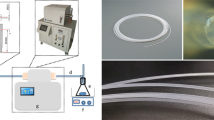Abstract
In-situ synthesis of nano-particles using the self-assembly of molten salt and super soluble micellae was proposed based on a phenomenon of super solubilization of molten salt in reverse micellae and its self-assembly when the concentration reached up to 95% (w/w). The mechanism of the self-assembly indicates that the self-assembly of molten salt occurs in a reverse micelle where a homogenous phase is established between 5% (w/w) of a surfactant with a VB value of less than 1 and a hydrocarbon species. This synthesis has some unique features, such as being free of water, highly effective deposition and narrow distribution of particle size.
Similar content being viewed by others
References
Lisiecki I, Billoudet F, Pileni M P. Control of the shape and size of copper metallic particles. J Phys Chem-US, 1996, 100(10): 4160–4166
Moumen N, Pilieni M P. Control of the size of cobalt ferrite magnetic fluid. J Phys Chem-US, 1996, 100(5): 1867–1873
Pileni M P. Reverse micelles as microreactors. J Phys Chem-US, 1993, 97(27): 6961–6973
Tanori J, Gulik-Kraywicki T, Pilieni M P. Phase diagram of Copper(II) bis(2-ethylhexyl) sulfosuccinate, Cu(AOT)2-isooctane-water. Langmuir, 1997, 13(4): 632–638
Tanori J, Pilieni M P. Control of the shape of copper metallic particles by using a colloidal system as template. Langmuir, 1997, 13(4): 639–646
Horvath O, Fendler J H. CdS-particle-mediated transmembrance photoelectron transter in surfactant vesicles. J Phys Chem-US, 1992, 96(24): 9591–9594
Wang J Y, Uphaus R A, Ameenuddin S, et al. Formation of nanoscale size cadmium sulfide within a channel protein monolayer. Thin Solid Films, 1994, 242(1–2): 127–131
Fendler J H. Membrane Mimetic Approach to Advanced Materials. Berlin: Springer-Verlag, 1992
Urquart R S, Furlong D N, Mansur H, et al. Quartz crystal microbalance and UV-Vis absorption study of Q-state CdS particle formation in cadmium aracchidate Langmuir-Blodgett films. Langmuir, 1994, 10(3): 899–904
Moriguchi I, Hosoi K, Nagaoka H, et al. Stepwise growth of size-confined CdS in the two-dimensional hydrophilic interlayers of Langmuir-Blodgett films by the repeated sulfidation-interaction technique. J Chem Soc Faraday T, 1994, 90(2): 349–354
Tian Y C, Wu C J, Fenlder J H. Fluorescence activation and surface-state reactions of size-quantized Cadmium sulfide particles in Langmuir-Blodgett films. J Phys Chem-US, 1994, 98(18): 4913–4918
Herron N, Wang Y, Eddy M, et al. Structure and optical properties of CdS superclusters in zeolite hosts. J Am Chem Soc, 1989, 111(2): 530–540
Boutonnet M, Kizling J, Maire P S. The preparation of monodisperse colloidal metal particles from microemulsions. Colloids Surf, 1982, 5(3): 209–225
Jacobsted C J H, Madsen C, Janssens T V W, et al. Zeolites by confined space synthesis-characterization of the acid sites in nanosized ZSM-5 by ammonia desorption and Al/Si-MAS NMR spectroscopy. Micropor Mesopor Mat, 2000, 39(2): 393–401
Israelachvili J N. Intermolecular and Surface Forces. 2nd ed. San Diego: Academic Press, 1992. 366–394
Wang D C. A novel idea on high interior phase emulsion. In: Huang Ping, Li Shengcai, Wang Yajun, eds. Theory and Practice of Energetic Materials. Beijing: Science Press, 2003. 91–95
Wang D C. A preparation method of nano composite oxide. CN200510046480.6, 2005-05-18
Wang D C. A study of identifying the emulsion type of surfactant: volume balance value. J Colloid Interf Sci, 2002, 247(2): 389–396
Chai L H, Peng X F. Challenge from frontier in chemistry: Dynamic self-assembly. Prog Chem, 2004, 16(2): 169–173
Kresge C T, Leonowicz M E, Roth W J, et al. Order mesporous molecular-sieves synthesized by a liquid-crystal template mechanism. Nature, 1992, 359: 710–712
Wang D C. A preparation method of slow released fertilizer. CN 1120144C, 2003-09-03
Wang D C. A preparation method of nano super paramagnetism material. CN 200510046479.3, 2005-05-18
Author information
Authors and Affiliations
Rights and permissions
About this article
Cite this article
Wang, D. In-situ synthesis of nanoparticles via supersolubilizing micelle self-assembly. SCI CHINA SER B 50, 105–113 (2007). https://doi.org/10.1007/s11426-007-0007-y
Received:
Accepted:
Issue Date:
DOI: https://doi.org/10.1007/s11426-007-0007-y




